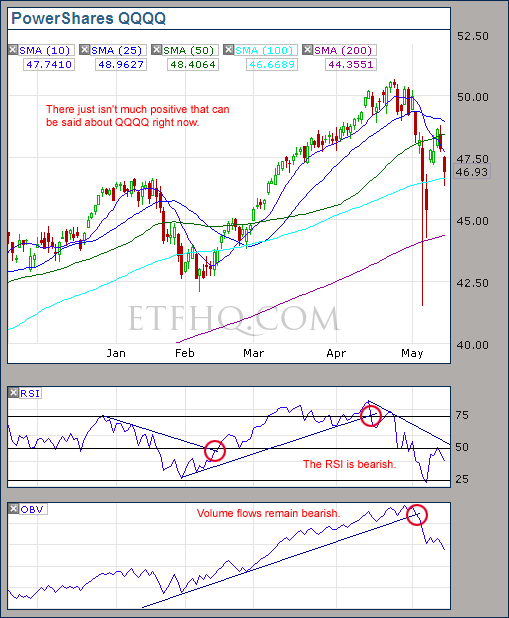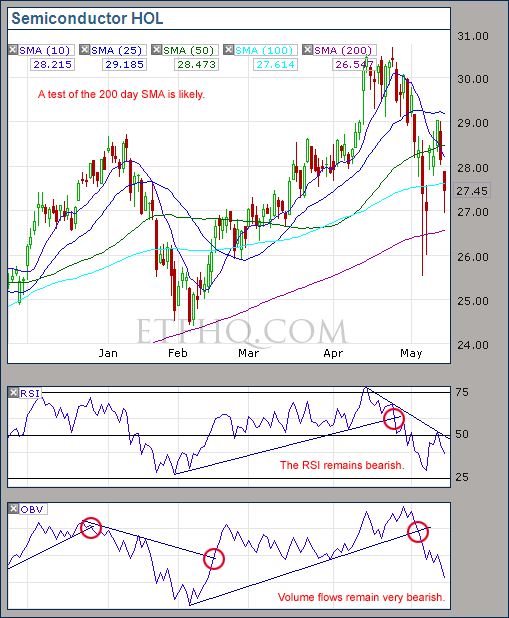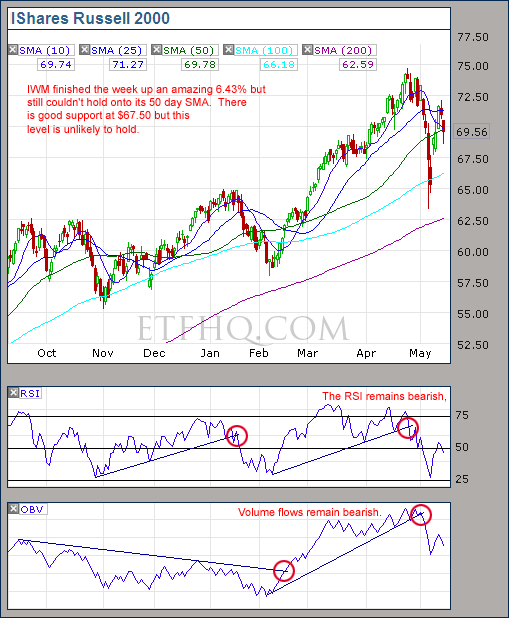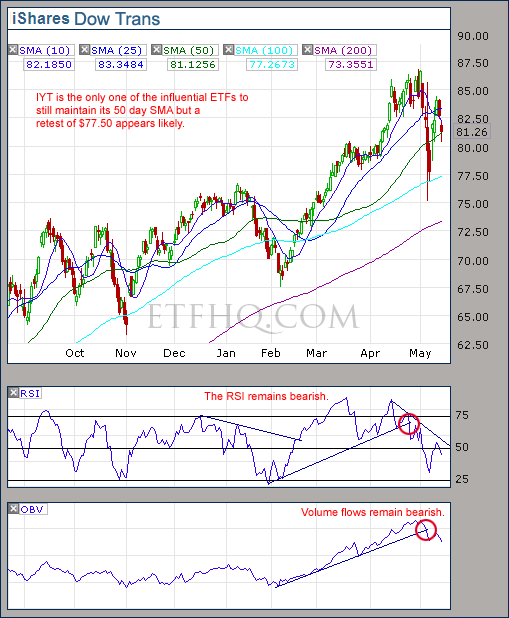May 17, 2010 – 07:15 am ET
It is amazing what you can buy with a Trillion dollars and the market was up violently on Monday but nothing has really improved from a technical perspective in fact, it has deteriorated.
.
ETF % Change Comparison
.

IWM had an amazingly good week and advanced over 6% while SMH was the worst performer advancing a comparatively small 1.7%. Of the 6 influential ETFs, SMH has been the worst performer by every measure including being the first to peak 29 days ago. This is concerning because the semiconductors tend to show the markets true direction.
.
What the % Comparison Table Tells Us:
By comparing the performance of the economically sensitive (SMH, QQQQ, IWM, IYT) and the comparatively stable ETFs (SPY and DIA) we can get an indication of the true market direction. The more sensitive areas of the market tend to be the first to initiate a trend change. For example if DIA and SPY sell off heavily while SMH and IWM (Russell 2000 small cap ETF) sell of mildly or continue moving to new highs then this would be very positive and vice versa.
The ‘Average Rank %’ is calculated by subtracting the % change for each ETF from the maximum % change and dividing it by the range for each period. 1-((MAX(% change all ETFs)-ETFs % Change)/(MAX(% change all ETFs)-MIN(% change all ETFs))) The readings for each period are then averaged. This reading is provided because if one ETF was significantly under/out performing the others then a plain high or low rank would not accurately reflect this.
.
![]()
.
A Look at the Charts
.

SPY has finally broken the bullish volume trend that has existed since March 2009 indicating that we have returned to a bear market.
.

QQQQ ended the week lower than it opened on Monday showing that the enthusiasm for the latest round of easy money is fading.
.
SMH is not offering any encouraging signs.
.

It is good to see the small caps holding together so well as they are highly economically sensitive but for now best case scenario is likely to be consolidation.
.

The Transports also closed the week below Mondays open. They have performed so well over the last few months which is unusual behavior if we are experiencing a major market reversal. The maintenance of support at $77.50 will be important if the bulls are to stage a comeback.
.
![]()
.
OM3 Weekly Indicator
.

Not really decisive signals from the OM3 Indicator but far from healthy.
.
How to read the OM3 indicator
The OM3 indicator as with most of our models primarily reads price action and volume. The strong/weak buy/sell signals are self-explanatory. ‘No Signal’ means that the component readings are in conflict and cancel each other out.
The alerts let you know if the cycle is speeding up or slowing down, so when you get at ‘Strong Buy, Bear Alert’ for instance it simply means that the criteria for a strong buy is in place but this weeks cycle reading is weaker (or more bearish) than last weeks reading (the same is true in reverse).
The number of weeks that a signal has been repeated is displayed. Historically a ‘Strong Buy’ signal has lasted for an average of 6 weeks and a maximum of 42 weeks, while a ‘Strong Sell’ has lasted for an average of 4 weeks and a maximum of 16.
This is an indicator not a mechanical trading model. It is useful to assist in analyzing the market but for the best results should be combined with commonsense and support/resistance levels etc.
.
![]()
.
TransDow & NasDow
.
The Transports remain dominant over the Dow and have outperformed the Dow 8.54% to 2.86% over the last 77 days. On a negative note the Dow is once again dominant over the NASDAQ, this raises the risk level in the market.
.
What the TransDow Readings tell us:
The TransDow measures dominance between the DJ Transportation Index (DJTI) and the Dow Jones Industrial Average (DJIA). In a strong market the more economically sensitive Transportation Index should be dominant over the DJIA.
Historically the DJTI has been dominant over the Dow 45% of the time. The annualized rate of return from the DJTI during this period was 18.47% with the biggest loss for one trade sitting at -13.27%. The annualized return from the DJIA during the periods it was dominant over the DJTI was just 4.06% and the biggest loss for one trade was -16.13%. A 4% stop-loss is applied to all trades adjusting positions only at the end of the week.
What the NasDow Readings tell us:
The NasDow measures dominance between the NASDAQ and the DJIA. Using the same theory behind the Trans Dow; in a strong market the more economically sensitive NASDAQ should be dominant over the DJIA.
Historically the NASDAQ has been dominant over the DJIA 44% of the time. Taking only the trades when the NASDAQ is above its 40 week moving average the annualized rate of return was 25.47% with the biggest loss for one trade sitting at –8.59%. The annualized rate on the DJIA during the periods it was dominant over the NASDAQ is just 8.88% and the biggest loss for one trade was –12.28%. A 8% stop-loss is applied to all trades adjusting positions only at the end of the week.
.
![]()
.
LTMF 80 & Liquid Q
.

This is positive, both the LTMF 80 and Liquid Q still have open positions in QQQQ. LTMF 80 however is not far off issuing a sell signal.
.
Historical Stats:
.

.
How The LTMF 80 Works
LTMF stands for Long Term Market Forecaster. It reads volume flows relative to price action and looks for out performance of volume measured on a percentage basis over the prior 12 months. During a sustained rally the readings will reach high levels (near 100%) making it imposable for the volume reading to always outperform price so any reading above 80% will maintain the buy signal. This system has outperformed the market over the last 10 years but performance has been damaged by some nasty losses. It only produces buy signals and only for QQQQ.
How Liquid Q Works
Liquid Q completely ignores price action and instead measures the relative flow of money between a selection of economically sensitive and comparatively stable ares of the market. It looks for times when the smart money is confident and and can be seen by through volume investing heavily is more risky areas due to an expectation of expansion. This system has outperformed the market over the last 10 years and remained in cash through most of the major declines. It only produces buy signals and only for QQQQ. We will provide more performance details on the web site for these systems soon.
.
![]()
.
Summary
.
I am at a stretch to find positive things to say about the current market. There is the fact that the small caps have been holding together comparatively well and the fact that LTMF 80 and Liquid Q still have open trades. Otherwise, volume flows are bearish across the board, the market is no longer oversold and no one has another Trillion dollar bailout surprise up their sleeve. The bears are in control and there is nothing apparent that the bulls can do to stop them for now.
.
Any disputes, questions, queries, comments or theories are most welcome in the comments section below.
.
Derry
And the Team @ ETF HQ
“Equipping you to win on Wall St so that you can reach your financial goals.”
.
P.S Like ETFHQ on Facebook – HERE
.
![]()
.
The Devils Dictionary – N
NINJA Loan – No Income No Job No Assets. A type of loan whose source of repayment is a miracle but when pooled creates a new security of which 80% is somehow rated AAA due to the theory of diversification. Merton and Miller describe diversification as the only free lunch in the capital markets. This has now been refined as a necessary condition since without free lunch every one on Wall Street will starve to death.
O
OIBITDA – Operating Income Before Interest Taxes Depreciation and Amortization. The primary valuation measure used by Bernie Madoff’s accountants. Currently being reformulated as OYBITDA.
Option – A financial instrument that offers multiple ways of losing money. If being long vega doesn’t kill you, the decay will.